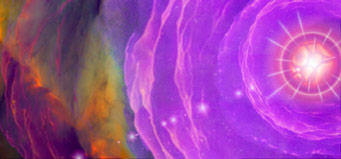
In this artist's view of Betelgeuse's upper chromosphere (seen here as violet and blue ), shock waves from the star pass through the chromosphere and enter into the cooler dust region (orange).
Alex Lobel (Harvard-Smithsonian Center for Astrophysics)
What causes Betelgeuse to vary in brightness? Like many red supergiants it changes slowly and irregularly, sometimes differing by a half magnitude or more from one year to the next — enough for a careful naked-eye starwatcher to recognize.
New measurements taken with the Very Large Telescope interferometer in Chile may help to answer why — and also why red supergiants have bigger atmospheres than astronomers can explain. Some researchers have thought a changing dust envelope might be veiling light from below. Others, looking at the star's ultraviolet light, thought a totally new phenomenon could be responsible. At least one team proposed the idea of colossal convective cells. But new high-resolution data collected with the multi-telescope interferometer is allowing astronomers to characterize Betelgeuse and its immediate surroundings in greater detail than ever before.
Guy Perrin (Paris Observatory) was part of an international team that measured two main components of Betelgeuse: the star's large photosphere (visible surface) and a cooler shell of molecular gas, or "MOLsphere," extending from 0.3 to 0.4 stellar radii above the surface. The results are an important step toward understanding how giant stars shed mass and pollute space with the molecules and dust required for new star and planet formation.
"We see dust at quite large distances from Betelgeuse, where the temperature is much cooler than at the star's surface, but we do not see it close to the star, where the heat will destroy the dust. There is a gap, and we've been trying to understand that gap," says Perrin.
In that gap, something causes dust to start to condense. The something seems to be a special type of glassy corundum (aluminum oxide, Al2O3). Corundum survives high temperatures and could exist in solid form quite close to a star in part because it is transparent at optical and ultraviolet wavelengths. Its ability to withstand extreme environments makes it a promising candidate to be the first nucleating site for particles in an outflowing stellar wind, similar to the way dust particles start the condensation of water droplets in a rain cloud.
"We hope we found the clue to understanding how grains can form quite close to the star and the process of how they are moved away from the star from radiation pressure. We think corundum is going to play a major role in this process," says Perrin.
Using the interferometer (S&T: February 2007 issue), Perrin's team mapped the size and temperature of the MOLsphere at mid-infrared wavelengths. Recently, scientists looking at spectroscopic data had debated whether Betelgeuse had a MOLsphere at all. This shell model, now confirmed, promises to be a fruitful tool in understanding the end stage of stellar life. The researchers' paper (see preprint) appears in the November 1st issue of Astronomy and Astrophysics.
 0
0
Comments
You must be logged in to post a comment.